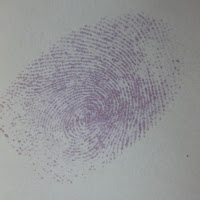Nonabsorbent surface (typically hard or smooth surfaces such as mirror, tile, glass, painted wood)
- Developed with application of powder
- Picked by best contrast to background
- Black is applied to white surfaces while grey/silver is applied to dark surfaces
- Grey/Silver is also applied to mirrors & polished surfaces (because they photograph black)
- Black powder is composed of black carbon or charcoal
- Grey/silver is composed of mainly aluminum dust
- Applied with fiberglass/camelhair brush
- Stick to residue (like body oils)
- Another powder is the magnetic-sensitive which can be spread with magnet brush (Magna Brush)
- Decreases chance of damaging print because brush doesn't have bristles that touch the surface
- Florescent powders can be used for the use under ultraviolet light
Porous Surface (typically absorbent surfaces such as cloth, paper, cardboard, ect)
One method is iodine fuming
Typically used on latent prints
Has been historically recognized as one of earliest ways to develop latent prints
Non-destructive and should be first attempt at developing prints
Simply putting iodine fumes on print develops it
Iodine fuming was replaced with the chemical ninhydrin
In 1910, Siegfried Ruhemann found that when it was heated (between 80-100 Celsius) it produce bluish-purplish color (known as Ruhemann's purple)
In 1954, Oden and Hofsten thought to use it to develop prints in criminal investigations
Now it's the most widely used method on porous surfaces
Sometimes, certain treated/printed papers might react with ninhydrin
BOTH METHODS ALSO USED AS NONABSORBENT DEVELOPERS






I find this very to the point and factual. It's useful for quickly locating individual facts however if possible I reccomend going into a little more depth. I know it's difficult in a section where it's mainly listed but for instance you could tell in a breif sentance how iodine fuming works. Just my two cents.
ReplyDelete